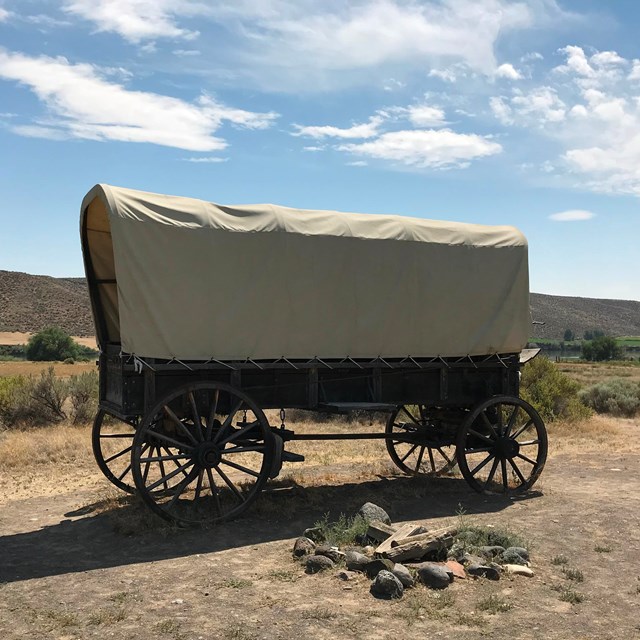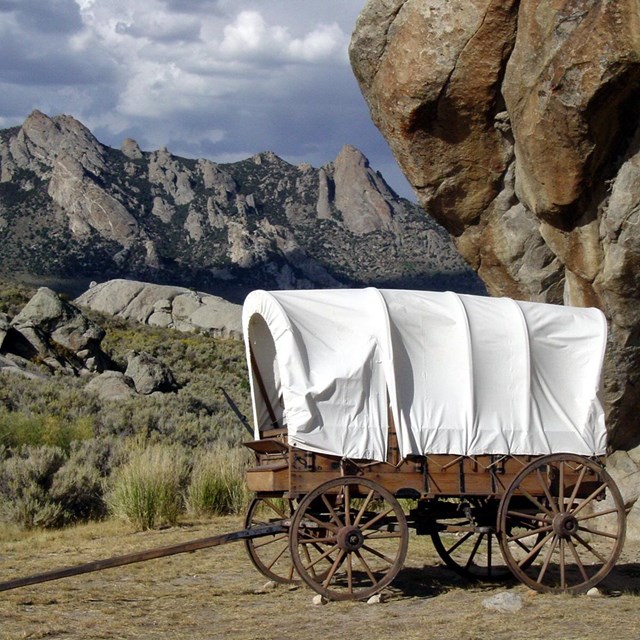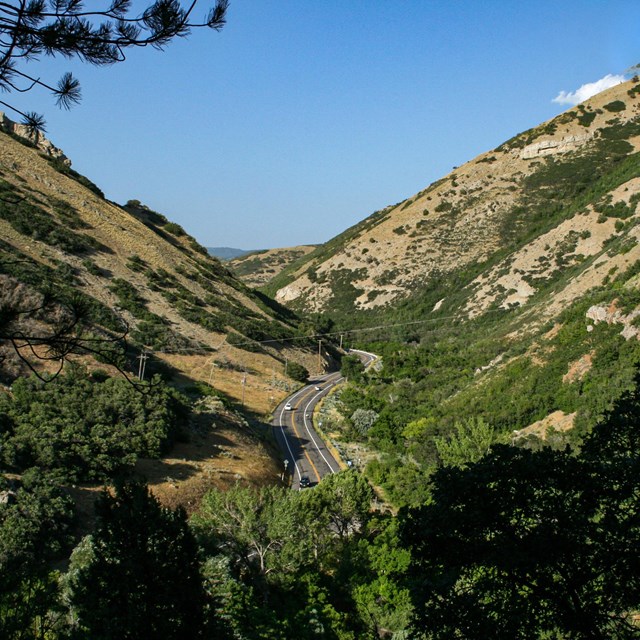Last updated: March 28, 2022
Article
Chapter 1: Race, Slavery, and Freedom - The Early Black Presence
Sweet Freedom's Plains
African Americans on the Overland Trails 1841-1869
By Shirley Ann Wilson Moore, PhD.
For the National Park Service
National Trails Regions 6, 7, & 8
Chapter 1 Sections
- The Early Black Presence
- The Question of Race
- The Evolution of Their Status
- The Contagion of Liberty
- Permanent, Hereditary Chattel: A Snapshot of Antebellum Slavery in the South, Indian Territory, and Border States
- Northern “Unfreedom”
- The Nature of Freedom in the West
- Utah: Slaves and Saints
- No Rights to be Respected
People of African descent have been an integral presence on the American continent since the early days of Spanish and other European exploration. African Americans who set out on the overland trails in the nineteenth century were not the first black people to journey across the continent in search of freedom, riches, land, and adventure. Historian Quintard Taylor has noted that “African American life in the West began with nature’s violence” when Esteban (also known as Estevanico), the Moroccan slave of Spanish explorer Andrés Dorantes de Carranza, accompanied his owner on Pánfilo de Narváez’s 1527-1528 treasure-hunting expedition in the Gulf of Mexico. Narváez’s fleet was destroyed by a hurricane and Esteban, cast ashore with 15 other men, became the first African to set foot in what would later become Texas and the western United States. He and his party endured many hardships, including a starvation winter on a sandbar near present-day Galveston. They were captured by coastal Indians and spent five years enslaved by them. By September 1534, Esteban was one of four survivors of the original party. He and this small group, led by Álvar Nuñez Cabeza de Vaca, escaped their captors and fled into the interior, where they encountered friendly native people. Esteban’s skill and fluency in sign language thrust him into the important roles of interpreter, ambassador, and negotiator with the native populations of the region. His efforts helped the depleted band of conquistadors survive an eight-year, 15,000-mile march across the Southwest. With the help of the Shuman Apaches, whose guidance Esteban helped secure, the group crossed the Rio Grande and trudged through Chihuahua and Sonora, finally arriving in Mexico City in July 1536.
While Esteban is the first and best-known black explorer with the Spanish, he was not the only one. In 1540-1542, Francisco Vásquez de Coronado’s expedition retraced Esteban’s path to the northern frontier. Coronado’s company included an entourage of more than 1,000 people, among whom were Africans and Indians. A free black man served as interpreter for Juan de Padilla, the friar for the Coronado company. When Padilla remained behind to minister to the Kansa Indians in 1541, the black interpreter stayed with him.10
Nearly 300 years later, a black man named York would travel the West some 40 years before the great overland emigrations commenced. York made his journey as the personal servant and slave of Captain William Clark, who, with Meriwether Lewis, led an exploratory expedition from St. Louis to the Pacific in 1804 to 1806. York was the first documented American slave to cross the continent. As Esteban did for his party three centuries earlier, he contributed crucial interpreting, trading, and scouting skills to the Lewis and Clark Corps of Discovery expedition. Although much about him remains a mystery, York has been described as “large, dark, agile and strong,” and his ability to establish rapport and negotiate with Indian tribes was notable. (see Appendix, Chapter 1, Photo 1). York was recognized and treated as a full member of the party, engaging in decision- making, voting, and hunting. However, his considerable contributions to the expedition were not rewarded with freedom. Instead, Clark chose to hold onto him for another 10 years after the trip, much to the dismay and anger of the black man, who wanted to be freed and reunited with his wife in Kentucky. Clark resorted to beating, imprisoning, and threatening York with sale in an unsuccessful effort to break his defiance. Clark finally freed him in 1816, but the black explorer’s final fate is unclear. William Clark contended that York hated being free and died while attempting to return to him. Mountain man Zenas Leonard provides another account, which has York living among the Crow Indians as a respected member of the tribe in the 1830s. Still another version of the story contends that York remarried and spent a comfortable life as the owner of a drayage service operating between his home in Louisville, Kentucky, and Nashville, Tennessee.11 York, mountain man James Beckwourth, mapmaker T. H. Jefferson, and other black frontiersmen helped blaze the trail for overland emigrants who would make their way west in the coming decades.12
Next Section - Chapter 1, Race Slavery Freedom: The Question of Race
10 Esteban, a native of Azamor, on the Atlantic shore of Morocco, was also known as Estevanico, Estevan, Estebanico, Black Stephen, and Stephen the Moor. For Esteban’s story and the presence of other early blacks with Spanish expeditions, see Taylor, In Search of the Racial Frontier, 27-43; Donald E. Chipman, “Estevanico,” Handbook of Texas Online, published by the Texas State Historical Association, http://www.tshaonline.org/handbook/online/articles/fes08, [accessed January 3, 2012]; George P. Morehouse, “Padilla and the Old Monument near Council Grove,” Kansas Historical Collections 10 (1908): 472-479. See also “Isabel de Olvera Arrives in New Mexico,” in Taylor and Moore, eds., African American Women Confront the West, 31; Dedra S. McDonald, “To be Black and Female in the Spanish Southwest,” in Taylor and Moore, African American Women Confront the West, 32-52; A. D. F. Bandelier, ed., The Journey of Álvar Núñez Cabeza de Vaca (New York: A.S. Barnes, 1905), 52-54, 65; and Rick Moss, “Not Quite Paradise: The Development of the African American Community in Los Angeles Through 1950,” California History 75, no. 3 (Fall 1996): 222-224.
11 Darrell Millner, “York,” The Black Past: An Online Reference Guide to African American History, BlackPast.org, http://www.blackpast.org/?q=aaw/york [accessed September 18, 2010]; Darrell M. Millner, “York of the Corps of Discovery: Interpretations of York’s Character and His Role in the Lewis and Clark Expedition,” Oregon Historical Quarterly (Fall 2003): 2-25 http://www.historycooperative.org/journals/ohq/104.3/millner.html [accessed September 18, 2010]; Taylor, In Search of the Racial Frontier, 48-49.
12 These are only a few of the early black explorers who lived and worked in the West before the era of overland emigration. Other significant African American trailblazers include Edward Rose, the son of a white trader and a black-Cherokee woman who joined the Manuel Lisa fur trading expedition to the Bighorn River in present-day Wyoming in 1806. He periodically worked as a guide, hunter, and trapper for several fur-trading companies, but lived as a valued member of two Indian nations, learning their languages and customs. The Absaroka (Crow) nation adopted him in 1807, and the Arikara did so in 1830 in what is now South Dakota. Rose allied himself with the Indian societies against potential enemies and was an important link with world of the fur traders. See Taylor, In Search of the Racial Frontier, 49-50. Peter Ranne, a black member of Jedediah Smith’s Southwest Expedition of 1826, trapped beaver throughout the Cache Valley and traveled as far as present-day San Bernardino, California. Polette Labross was a “mulatto” (a person of mixed race) who took part in Smith’s second expedition in 1827. See Ronald Coleman, “A History of Blacks in Utah” (PhD diss., University of Utah, 1980), 28-29.




